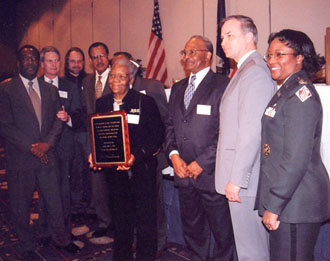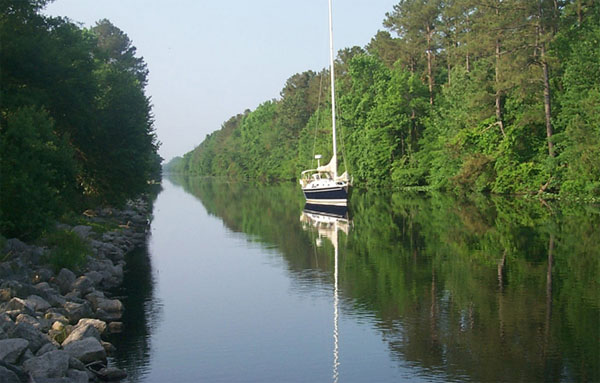The Norfolk District Manages One of the Nation’s Oldest Artificial Waterways
The Dismal Swamp Canal winds it way through both Virginia and North Carolina. It is a 22- mile-long waterway connecting the Chesapeake Bay to the Albemarle Sound by way of the Elizabeth and Pasquotank Rivers. The canal forms part of the Atlantic Intracoastal Waterway, which as currently conceived runs from Norfolk, Virginia, to Miami, Florida. Of the many canals constructed throughout America during its formative years, it remains one of the few from the early national period still in operation. It was placed on the National Register of Historic Places in 1988 and is designated as a National Civil Engineering Landmark.
 |
Mrs. Ethel Grandy (center) and other descendants of Moses Grandy are acknowledged by local, state and federal officials, including (on Mrs. Grandy's
left) Congressmen Jones and Forbes and Norfolk
District Engineer Col. Yvonne Prettyman-Beck.
(Photo courtesy Norfolk District) |
First proposed in 1728, construction of the canal did not begin until George Washington and Patrick Henry facilitated the establishment of the Dismal Swamp Canal Company in 1784. The canal began to carry limited traffic in 1805, but the company soon fell on hard times. Further progress stalled until Congress purchased a large share of stock in 1826. Bolstered by Congressional support and with surveys conducted by the Corps in hand, the company was able to complete an essentially new canal in 1828.
In addition to carrying commercial traffic, the canal became a popular and inspirational recreation area. Edgar Allen Poe reportedly wrote parts of his famous poem “The Raven” while traversing its length and overnighting on its banks. Furthermore, novelists Harriet Beecher Stowe and Henry Wadsworth Longfellow based some of their literary characters on slaves they witnessed participating in the canal’s construction. Indeed, the slave role was of such significance that in February 2004, the Norfolk District Engineer presented a plaque to descendants of Moses Grandy, a slave who made key contributions towards the canal’s construction.
Additionally, as the canal was a component of the “underground railroad” of trails and safe houses for slaves escaping to freedom in the North, the National Park Service has officially recognized it as part of the National Underground Railroad Network to Freedom program.
In addition to carrying commercial traffic, the canal became a popular and inspirational recreation area. Edgar Allen Poe reportedly wrote parts of his famous poem “The Raven” while traversing its length and overnighting on its banks. Furthermore, novelists Harriet Beecher Stowe and Henry Wadsworth Longfellow based some of their literary characters on slaves they witnessed participating in the canal’s construction. Indeed, the slave role was of such significance that in February 2004, the Norfolk District Engineer presented a plaque to descendants of Moses Grandy, a slave who made key contributions towards the canal’s construction. Additionally, as the canal was a component of the “underground railroad” of trails and safe houses for slaves escaping to freedom in the North, the National Park Service has officially recognized it as part of the National Underground Railroad Network to Freedom program.
Throughout the nineteenth century, the canal’s drafts were deepened and the locks reduced from six to two. This canal also faced competition from the Albemarle and Chesapeake Canal, opened in 1859, for the lumber, cotton, and tobacco that plied along its route. In 1862, Union forces built and fortified earthworks around the canal to prevent its use by Confederates. Following disrepair after the Civil War, a private concern revitalized the canal in the mid-1890s.
But with the advent of the twentieth century and its more efficient modes of transport, the canal became uneconomical to operate. In 1929, the federal government purchased the canal for $500,000 and designated the U.S. Army Corps of Engineers to maintain and operate it for public benefit. Despite rumors of ceasing the operation of the canal, the Corps has periodically engaged in significant efforts to save it. After Hurricane Isabel devastated the area in the fall of 2003, the District was able to clear almost 700 downed trees and other debris to reopen the canal in only three weeks.
The canal is now used solely for pleasure craft, of which nearly 1,700 cruise its length annually. While transited mostly by sailboats, the canal’s centerline depth, maintained at over six feet, does allow for motorboat access. Its length generally parallels U.S. Highway 17, and most boaters use it to travel from Norfolk to Elizabeth City. The canal has different depths at its starting and end points. Water to the canal is fed from Lake Drummond in Virginia, which can be reached by traveling the feeder ditch or an electric railway.
The tannin in the water gives it both a brownish color and also limits the growth of bacteria. Blue herons, deer, black bear, and other wildlife abound along its course. The Dismal Swamp Canal remains a true historic and naturalist treasure.

Recreational boaters enjoy the tranquil, pristine beauty that the canal's passage offers
* * *
September 2004